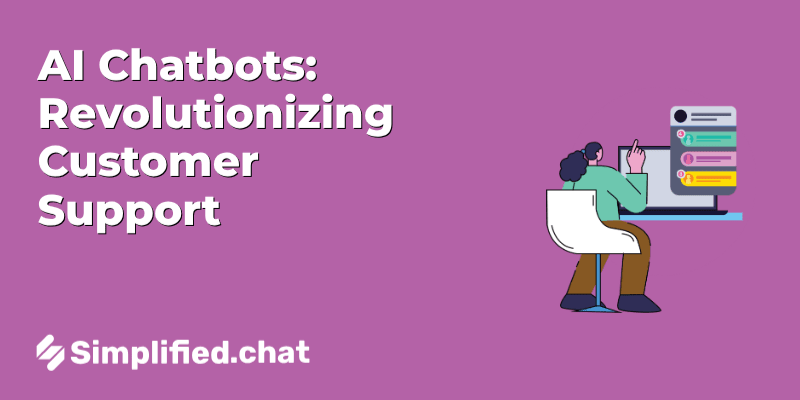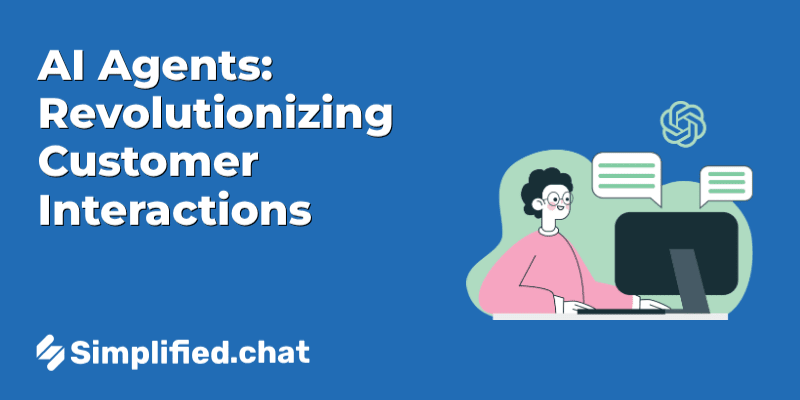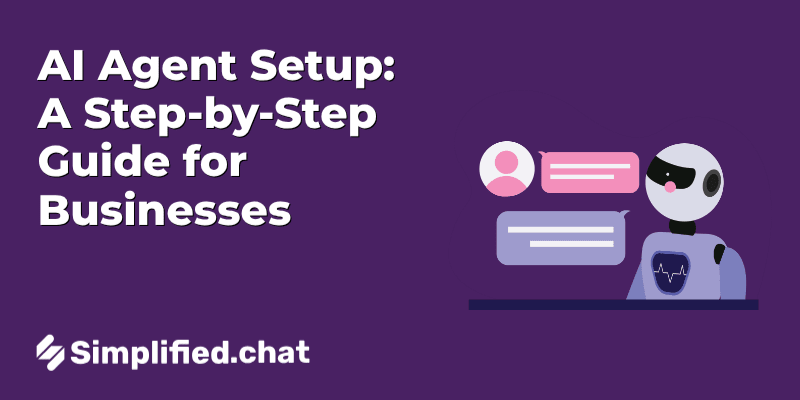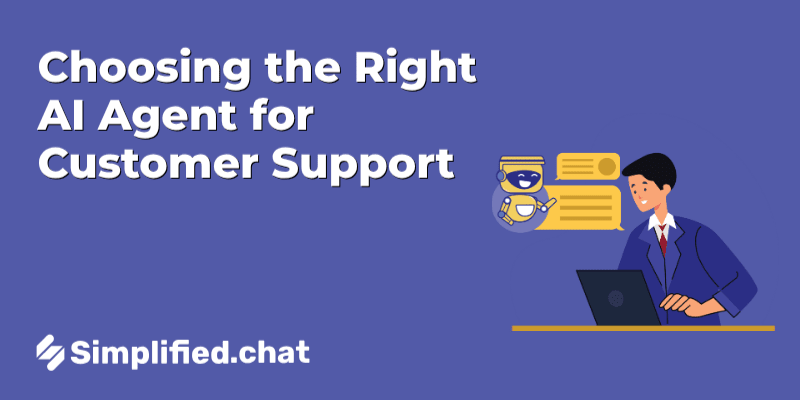Table Of Content
How Are AI Chatbots Transforming Customer Support?
AI chatbots are intelligent virtual assistants that provide businesses with a way to engage customers around the clock. These chatbots use natural language processing (NLP) and machine learning (ML) to understand user queries and provide relevant information or assistance quickly and efficiently. They improve customer support experiences by reducing wait times, delivering personalized responses, and offering immediate help.
AI chatbots are AI-powered virtual assistants that can engage in conversations with users, understand their queries, and provide relevant information or assistance. They leverage natural language processing (NLP) and machine learning (ML) to simulate human-like interactions, making them an invaluable tool for modern customer support.
According to McKinsey's article, "The future of customer experience: Embracing agentic AI," intelligent AI-powered chatbots can autonomously make decisions and take actions that improve customer interactions and operational efficiency. The integration of AI into customer support is essential to meet evolving customer expectations and enhance service delivery across industries.
Current Trends in AI Chatbots

Artificial Intelligence chatbots continue to evolve beyond simple scripted interactions. Three key trends are shaping how these systems engage users and deliver value today. From advancements in language understanding to multi-platform presence, each trend plays a vital role in making chatbots more responsive and relevant across different environments.
Natural Language Processing (NLP) Advancements
Natural Language Processing forms the backbone of a chatbot's ability to comprehend and respond to human input. Recent improvements in NLP mean chatbots can now interpret nuances, slang, idiomatic expressions, and even ambiguous queries with higher accuracy. This allows conversations to feel more natural and less robotic. For example, instead of relying on hardcoded commands, modern chatbots generate responses based on contextual clues—helping meet user expectations for fluid dialogue.
Further, developments in pretrained language models have reduced the training time required to understand diverse vocabularies and dialogue structures. These models continuously improve by analyzing millions of interactions, which helps mitigate misunderstandings and refine response relevancy.
Personalization and Contextual Understanding
Today's chatbots are increasingly designed to recall user preferences and context over multiple interactions. This means they don’t treat each conversation as isolated but build an ongoing relationship, personalizing responses accordingly. For businesses, this translates into more meaningful customer service, tailored product recommendations, and proactive support.
For example, if a customer frequently inquires about a specific product category, the chatbot can remember this pattern and suggest related items or updates without being prompted. This shift towards context-awareness relies heavily on storing session data securely and employing AI models that weigh prior interactions.
Integration with Multiple Platforms
Accessibility is crucial for chatbot effectiveness. By integrating seamlessly with various messaging channels such as WhatsApp, Facebook Messenger, and direct website chats, businesses ensure users can connect on their preferred platform without friction. This omnichannel approach widens reach and increases engagement opportunities.
Moreover, synchronization across platforms allows chatbots to maintain continuity in conversations, regardless of where users start or resume. This creates a cohesive experience that respects users’ habits and encourages ongoing interaction.
Benefits of AI Chatbots in Customer Support

AI chatbots have become essential tools for modern customer support teams. Their ability to deliver constant availability and prompt responses transforms how businesses interact with customers, setting new expectations for service quality and efficiency.
24/7 Availability and Instant Responses
One of the most valuable advantages of AI chatbots is their round-the-clock accessibility. Unlike human agents limited by shifts and working hours, chatbots can engage with customers at any time—including nights, weekends, and holidays. This continuous availability ensures that customers receive immediate assistance without delay, reducing frustration and improving their overall experience.
Instant responses not only provide quick answers but also help to streamline the support process. For straightforward queries or common issues, chatbots can instantly deliver accurate information or guide users through basic troubleshooting steps. This immediacy can dramatically reduce the time customers spend waiting for support, which studies have linked directly to increased satisfaction and brand loyalty.
Reduced Wait Times and Improved Customer Satisfaction
Traditional customer support models often involve queuing and significant waiting times due to limited agent availability. AI chatbots minimize these bottlenecks by handling multiple interactions concurrently. They efficiently triage incoming requests, providing solutions on the spot or directing more complex issues to human agents equipped to resolve them.
This approach leads to a noticeable decrease in wait times, which is crucial since long delays have been shown to lower customer trust and satisfaction. By resolving routine questions instantly, chatbots free customers from the frustration of hold queues, contributing directly to more positive service perceptions.
Cost Savings and Increased Operational Efficiency
From a business perspective, chatbots help trim operational expenses by automating repetitive tasks that would otherwise consume substantial human resources. They can handle a high volume of inquiries simultaneously without added overhead, making customer support more scalable and cost-effective.
Reducing the burden on human agents allows companies to reallocate these resources to solving complex issues and focusing on personalized service that requires emotional intelligence—areas where AI currently cannot replace humans.
In summary, the integration of AI chatbots in customer service offers:
- Constant, uninterrupted support ensuring customers feel valued anytime they reach out.
- Lower wait times, directly enhancing the quality and responsiveness of service.
- Operational efficiencies that save costs while maintaining, or even boosting, support quality.
These benefits together underline why many organizations consider AI-driven chatbots an indispensable part of their customer support strategy today.
Implementing AI Chatbots: A Strategic Approach

Introducing AI chatbots into your business operations is not just about adopting new technology; it requires a deliberate and strategic process. When implemented thoughtfully, chatbots can enhance customer interactions, streamline support, and free up human resources for more complex tasks. Here’s a breakdown of essential steps to take when integrating chatbots into your business landscape.
Defining Clear Objectives and Use Cases
Before selecting or building a chatbot, clarify what you want it to achieve. Pinpoint specific areas where chatbots can deliver tangible value and align with your broader business goals. Common use cases include:
- Answering frequently asked questions quickly and accurately to reduce wait times.
- Providing detailed product information on demand, helping customers make informed decisions.
- Resolving straightforward issues such as order status inquiries or basic troubleshooting.
Focusing on well-defined objectives helps avoid overcomplicating the chatbot’s role and ensures it complements your existing support channels effectively.
Choosing the Right Chatbot Platform
With a clear purpose, the next step is selecting a platform that matches your unique business needs. When evaluating chatbot platforms, consider factors like:
- Customization options to tailor responses and personality to your brand voice.
- Integration capabilities with your current tools, such as CRM systems or e-commerce platforms.
- Capacity to support growth and handle increasing user interactions smoothly.
For example, platforms that allow building custom AI chatbots provide flexibility to design interactions best suited to your audience. Choosing this carefully sets a strong foundation for long-term success.
Training and Optimization
Launching your chatbot is only the beginning. Continuous training and refinement are vital to ensure it responds accurately and remains helpful as customer needs evolve. This involves:
- Regularly analyzing chatbot conversations to identify gaps or misunderstandings.
- Updating the chatbot’s knowledge base with new information, FAQs, and product updates.
- Using feedback loops from users to fine-tune conversational flows and improve engagement.
Proactive optimization not only enhances user satisfaction but can also reveal new opportunities where the chatbot can support your business further.
Addressing Futuristic Demands in Customer Service

As customer expectations evolve, businesses are under increasing pressure to deliver service that is not just reactive but anticipatory, integrated, and insightful. Meeting these demands requires adopting technologies and strategies that reshape how support is provided.
Predictive Support: Anticipating Needs Before They Arise
One of the most notable advances in customer service comes from predictive support powered by AI chatbots. These systems analyze customer data—purchase history, browsing patterns, previous inquiries—to foresee potential issues or needs. For example, if a customer frequently requests troubleshooting help for a specific product, a chatbot can proactively offer assistance or relevant information before the issue escalates.
Studies show that anticipatory support reduces resolution times and increases customer satisfaction, as customers feel understood and valued even before reaching out. This approach moves customer service from reactive to proactive.
Omnichannel Experience: Seamlessness Across Every Touchpoint
Today's customers engage with brands across various platforms—social media, email, phone, chat, and more. A fragmented approach frustrates customers and undermines brand loyalty. Delivering a consistent, unified experience across all interactions is vital.
By integrating chatbots that operate across multiple channels, companies allow customers to transition effortlessly from one touchpoint to another without losing context. For instance, a customer can start a conversation via social media and continue it on a website chat with the same understanding and history preserved. This consistency reassures customers and simplifies their journey.
Data-Driven Insights: Turning Interactions Into Strategic Improvements
Every chatbot interaction generates data that is a valuable source of insights. By analyzing these conversations, businesses can identify common pain points, frequently asked questions, and emerging trends. This information helps shape product development, refine service protocols, and tailor marketing strategies.
Moreover, data-driven insights enable continuous improvement not only of chatbot responses but of the overall customer experience. For example, patterns in queries about shipping delays could prompt a company to improve logistics or update customer notifications proactively.
Integrating predictive support, omnichannel capabilities, and data analysis forms a cohesive strategy to meet customer service demands today and beyond. Businesses adopting these approaches position themselves to deliver more personalized, efficient, and insightful service that aligns with evolving customer expectations.
Exploring Practical Applications of AI Chatbots Across Industries

AI chatbots have transitioned from novelty tools to essential components in multiple sectors. Their ability to simulate human-like interactions while handling routine tasks efficiently makes them invaluable in enhancing user experience and operational efficiency. Below, we dive into three primary sectors where AI chatbots are making a tangible difference.
E-commerce: Enhancing Customer Experience and Streamlining Operations
In the fast-paced world of online shopping, customers expect quick responses and personalized assistance. AI chatbots meet these demands by:
- Providing tailored product recommendations based on browsing history and preferences, which can increase sales and customer satisfaction.
- Handling order processing queries efficiently, including order confirmations, changes, and tracking details without human intervention.
- Resolving shipping inquiries by offering real-time updates and addressing common questions about delivery times, costs, or delays.
Retailers benefit from reduced workload on support teams and improved customer engagement, which studies suggest can lead to higher conversion rates.
Healthcare: Supporting Patients with Accessible and Reliable Assistance
Healthcare providers increasingly incorporate AI chatbots to improve patient interaction outside traditional appointments. Their roles include:
- Scheduling and managing appointments, reducing administrative bottlenecks and allowing staff to focus on more complex tasks.
- Offering medically accurate, on-demand information for common health concerns, enabling patients to make informed decisions quickly.
- Providing ongoing support for patients managing chronic conditions, such as reminders for medication or lifestyle advice, contributing to better adherence and outcomes.
These applications not only enhance patient engagement but also free up valuable resources within healthcare settings.
Education: Facilitating Learning and Administrative Efficiency
In educational institutions, AI chatbots serve as versatile assistants capable of:
- Answering student questions about coursework, schedules, and campus services instantly, reducing wait times and frustration.
- Providing detailed course information and prerequisites, assisting students in making well-informed academic choices.
- Offering technical support for e-learning platforms, ensuring smooth access to digital resources without requiring constant IT intervention.
These benefits contribute to an improved learning environment, where students receive timely help and educators can focus more on teaching.
How AI Chatbots Are Redefining Customer Support Success
The role of AI chatbots in customer service continues to expand, delivering around-the-clock availability, faster issue resolution, and operational efficiencies that benefit both businesses and customers. By adopting intelligent chatbots, companies can provide more personalized and proactive support experiences that meet today's customer expectations.
Simplified.chat offers a platform that enables you to create tailored AI chatbots designed to fit your unique business needs, easily connecting with popular messaging platforms like WhatsApp and Facebook Messenger. Ready to enhance your customer support and increase satisfaction? Visit Simplified.chat today to start building your AI-powered chatbot and transform your customer interactions into meaningful engagement.
Empower Your Business with Simplified AI Chatbot
Build Your Own AI ChatbotBuild Your First AI Agent Today
Build, train, customize and deploy your first AI chatbot in minutes




